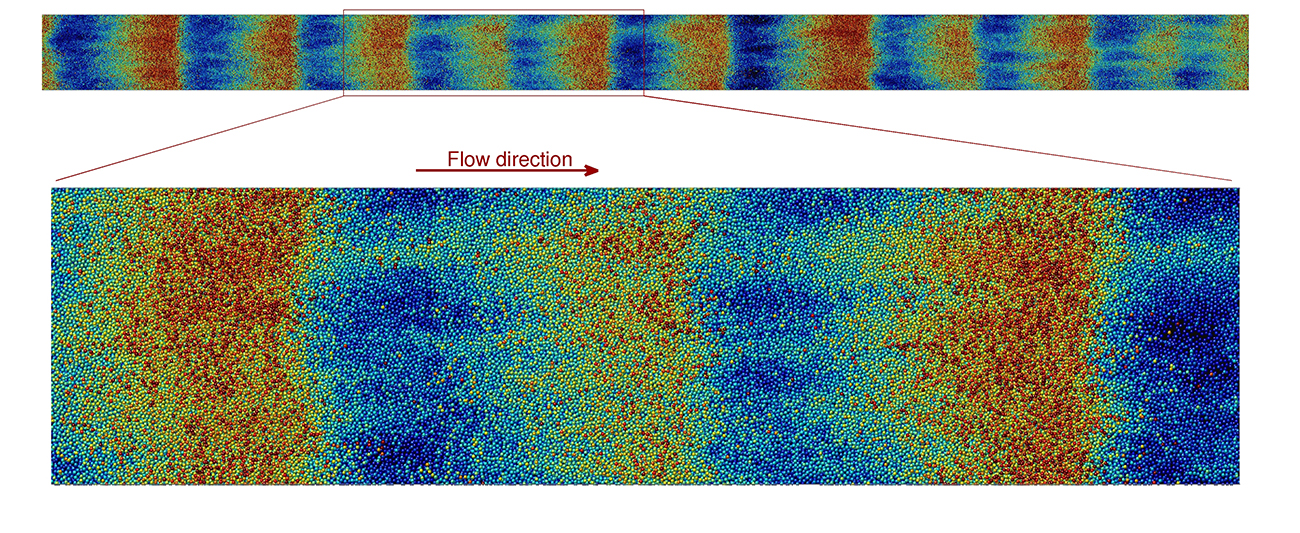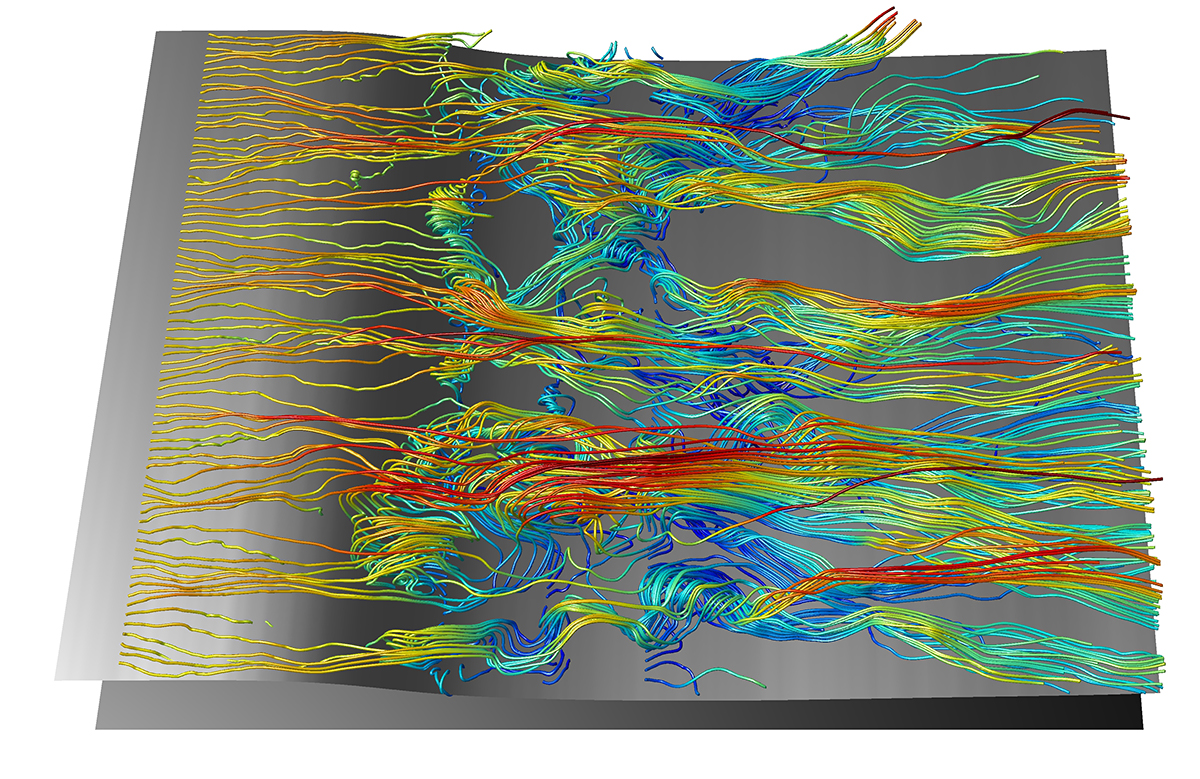ENVIRONMENT AND ENERGY
Direct Numerical Simulation of the Formation of Subaqueous Sediment Patterns
Principal Investigator:
Markus Uhlmann
Affiliation:
Institute for Hydrodynamics, Karlsruhe Institute of Technology/KIT (Germany)
Local Project ID:
pr58do
HPC Platform used:
SuperMUC of LRZ
Date published:
Scientists of the Institute for Hydrodynamics of the Karlsruhe Institute of Technology (KIT) have – for the first time – performed high-fidelity numerical simulations of the formation of sediment patterns in a channel flow configuration.
When a body of water flows over a sediment bed, erosion may take place which over time can lead to a change in the morphology of the bed itself. In this manner, rivers and ocean currents have been shaping the face of the earth for many years. Once the motion of sediment particles is initiated, a complex interplay between the solid grains and the carrier fluid ensues, especially when the base flow is turbulent. Under certain circumstances, small undulations in a flat subaqueous sediment bed are observed to be amplified and give rise to regular wavy patterns commonly termed as bedforms. An accurate prediction of the formation and characteristics of bedforms is highly important for the purpose of waterway management, planning and maintenance of various hydraulic structures, geophysics etc.
In this project scientists of the Institute for Hydrodynamics of the Karlsruhe Institute of Technology (KIT) have – for the first time – performed high-fidelity numerical simulations of the formation of sediment patterns in a channel flow configuration. The approach is novel in the sense that not only all relevant length and time scales of the turbulent flow are taken into account, but also the particles are fully resolved, i.e. the near-field of the flow around each individual particle is computed accurately. Moreover, in order to realistically capture the formation of bedforms, the researchers have adopted sufficiently large computational domains involving up to approximately 3.6 billion grid nodes, while the mobile sediment bed is represented by considering a very large number (up to approximately 1.1 million) of freely moving spherical particles. Consequently, the simulations performed are extremely demanding in terms of numerical code efficiency and computational resources. The project group has developed an efficient and precise numerical method capable of simulating such large-scale dense-particulate flows [1, 2] which was utilized to carry out the simulations on HPC system SuperMUC of the Leibniz Supercomputing Centre (LRZ) Garching.
A thorough analysis of the generated numerical data has allowed the scientists to address the initiation and evolution aspects of the patterns and the results obtained in the simulations are consistent with the available literature [3]. Moreover, the researchers rigorously analyzed the characteristics of the driving flow field and sediment grain motion. An instantaneous flow field and particle positions shown in figures 1–4 clearly highlight the complex interaction between the turbulent flow and the evolving sediment bed.
The results of these simulations can be expected to significantly contribute to the elucidation of the mechanisms responsible for the formation of patterns in flows with mobile sediment particles. It can be anticipated that such highly reliable numerical data will allow for an important advance in the theoretical description of the phenomenon of subaqueous pattern formation. The novelty and impact of this work has already been acknowledged by the community [4].

Figure 1: Top view of the three-dimensional instantaneous particle positions. The wall-normal dimension is visualized by coloring each particle according to its wall-normal location (increasing from blue to red).
Copyright: Institute for Hydrodynamics, Karlsruhe Institute of Technology (KIT)
Figure 2: Instantaneous three-dimensional flow field and particle positions. Strong vortical regions are shown by grey colored iso-surfaces. The particles are colored based on their wall-normal location, darker color showing particles located at lower wall-normal location and vice-versa. Color contours corresponding to the streamwise component of the velocity field are shown in the wall- perpendicular sections.
Copyright: Institute for Hydrodynamics, Karlsruhe Institute of Technology (KIT)
Figure 3: Spanwise vorticity shown on a streamwise-oriented wall-perpendicular plane. Intersection region of particles and the plane is shown in black.
Copyright: Institute for Hydrodynamics, Karlsruhe Institute of Technology (KIT)
Figure 4: Close-up showing the streamlines of the flow field in the vicinity of the sediment bed. The streamlines are colored according to their wall-normal location. The sediment bed is represented by a surface extracted based on a threshold value of the span-wise averaged solid volume fraction.
Copyright: Institute for Hydrodynamics, Karlsruhe Institute of Technology (KIT)References:
[1] M. Uhlmann. “ An immersed boundary method with direct forcing for the simulation of partic- ulate flows”. In: J. Comput. Phys. 209.2 (2005), pp. 448–476. DOI: 10.1016/j.jcp.2005.03.017.
[2] A. G. Kidanemariam and M. Uhlmann. “ Interface-resolved direct numerical simulation of the erosion of a sediment bed sheared by laminar channel flow”. In: Int. J. Multiph. Flow 67 (2014), pp. 174–188. DOI: 10.1016/j.ijmultiphaseflow.2014.08.008.
[3] A. G. Kidanemariam and M. Uhlmann. “ Direct numerical simulation of pattern formation in subaqueous sediment”. In: J. Fluid Mech. 750 (2014), R2. DOI: 10.1017/jfm.2014.284.
[4] M. Colombini. “ A decade’s investigation of the stability of erodible stream beds”. In: J. Fluid
Mech. 756 (2014), pp. 1–4. DOI: 10.1017/jfm.2014.391.
Scientific contact:
Aman G. Kidanemariam and Markus Uhlmann
Institute for Hydrodynamics
Karlsruhe Institute of Technology (KIT)
Kaiserstr. 12, D-76131 Karlsruhe/Germany
e-mail: markus.uhlmann@kit.edu